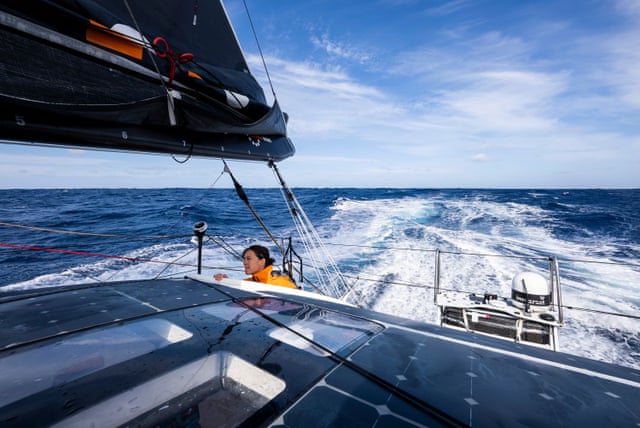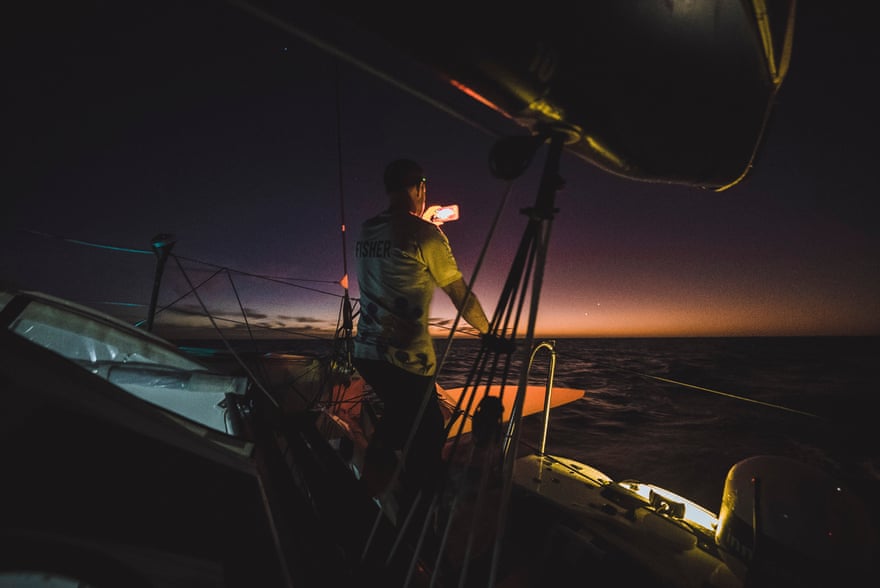‘It’s win-win’: how a dangerous sailing race could reveal the ocean’s secrets
From The Guardian by Yvonne Gordon
After a long hiatus, the epic Ocean Race is back – but this year, as well as dodging icebergs, cracking masts and suffering the occasional ‘hull sandwich failure’, the teams are gathering crucial data from places even research vessels rarely reach
The Southern Ocean is not somewhere most people choose to spend an hour, let alone a month.
Circling the icy continent of Antarctica, it is the planet’s wildest and most remote ocean.
Point Nemo – just to the north in the South Pacific – is the farthest location from land on Earth, 1,670 miles (2,688km) away from the closest shore.
The nearest humans are generally those in the International Space Station when it passes overhead.
But on 21 March, four sailing teams came through here – part of a marathon race round the bottom of the Earth, from Cape Town in South Africa to Itajaí in Brazil.
By the time these 18-metre (60ft) Imoca monohull sailing yachts neared Point Nemo, the five sailors on each boat had already been at sea for 23 days, with another two weeks to go before they reach port in early April.
And this is just leg three, the longest portion of the even longer Ocean Race, a 32,000-nautical-mile dash around the world that started in January and finishes in July.
Competition is fierce and racing is close, even after three weeks at sea.
Boat speeds on leg three so far have been up to 40.5 knots – the equivalent of gale force winds – and the vessels have, subject to ratification, broken the 24-hour distance record multiple times.
The crews survive on freeze-dried food (rehydrated with hot water from a kettle – there’s no kitchen), and operate a four-hour alternating watch system.
Nobody gets much sleep.
The toilet is a bucket.
Malama, the 11th Hour Racing yacht, cruises in abnormally calm Southern Ocean conditions.
All photographs courtesy Amory Ross/11th Hour Racing.
Video by Antoine Auriol
All photographs courtesy Amory Ross/11th Hour Racing.
Video by Antoine Auriol
The dangers are unpredictable.
Winds in the Southern Ocean can reach up to 70 knots and hitting an iceberg at speed would be catastrophic, so the boats have to steer clear of an ice exclusion zone around Antarctica.
On 1 March, the Team Malizia crew discovered a crack at the top of the mast, requiring one of them to climb up 28 metres in rough seas to patch it over in the middle of the night.
Guyot Environnement – Team Europe had to abandon leg three completely after suffering a “hull sandwich failure”, spending three nervous days sailing 600 nautical miles back to Cape Town for repairs.
The last time Team Holcim-PRB’s skipper Kevin Escoffier raced here, his boat broke in half and sank and he was rescued from his life raft.
But while the Ocean Race is sometimes known as the toughest, and certainly the longest, professional sporting event in the world – an event that began in 1973 as the Whitbread Round the World Race then became the Volvo OceanRace, and which attracts professional sailors of the highest level who join mixed crews every few years on sponsored teams to vie for an overall trophy (there is no cash prize) – this year scientists have smelled an opportunity for them to benefit as well.
Because the boats visit the most remote part of the ocean, which even scientific vessels struggle to access, this year the crews will seed scientific instruments all around Antarctica, aiming to measure 15 different types of environmental data – from ocean temperature and atmospheric indicators to concentrations of microplastic.
Information from the devices will help with everything from weather forecasting to insights into the climate emergency.
The Southern Ocean is one of the planet’s largest carbon dioxide sinks, for example, but its inaccessibility has meant that there is relatively little CO2 data available.
Because the boats visit the most remote part of the ocean, which even scientific vessels struggle to access, this year the crews will seed scientific instruments all around Antarctica, aiming to measure 15 different types of environmental data – from ocean temperature and atmospheric indicators to concentrations of microplastic.
Information from the devices will help with everything from weather forecasting to insights into the climate emergency.
The Southern Ocean is one of the planet’s largest carbon dioxide sinks, for example, but its inaccessibility has meant that there is relatively little CO2 data available.
Justine Mettraux of the 11th Hour Racing team takes a final look at the sail setup before ducking back into the cockpit
“The Southern Ocean is a very important driver of climate on a global scale [but] there is very little data,” says Toste Tanhua, chemical oceanographer at Geomar Helmholtz Centre for Ocean Research in Kiel, Germany.
“Data from the sailing races in the Southern Ocean is very important for us to understand the uptake of carbon dioxide by the ocean.”
Each boat is equipped with weather sensors on board that measure wind speed and direction, barometric pressure and air temperature.
Each team will drop two surface drifter buoys provided by organisations such as Météo-France and the US National Oceanic and Atmospheric Administration, which capture data to help the World Meteorological Organization study ocean currents and forecast extreme weather events such as hurricanes.
Course waypoints and the ice exclusion zone circles most of the world’s southern pole
A second type of buoy, the Argo profiler, deployed by Team Malizia in leg two, operates below the surface at depths of up to 2km, moving slowly with deep currents and transmitting information every 10 days.
The data is used for climate analysis as well as for long-range weather forecasts.
Meanwhile, 11th Hour Racing Team and Team Malizia are using OceanPacks to take regular water samples to measure the levels of carbon dioxide, oxygen, salinity and temperature, to be analysed in Germany and fed to Socat, the Surface Ocean CO2 Atlas.
Live dashboards give snapshots of the data as it is collected out at sea.
Tanhua says the fresh data reveals new patterns.
For example, it shows how carbon dioxide varies over a year – higher when the water warms up in summer, lower during a phytoplankton bloom.
It also shows how the ocean takes carbon from the surface and transports it into the depths.
“In the Southern Ocean, you have three major frontal systems where water is either going down vertically (sinking) or coming up,” Toste says.
“That has very different carbon levels.
Eddies also transport carbon up and down.” Scientists will now be able to observe these fronts and eddies up close, compare with satellite data and fill in the gaps.
11th Hour Racing team’s Charlie Enright and Jack Bouttell assess a tear in the mainsail
The boats are also sampling trace elements such as iron, zinc, copper, cadmium, nickel and manganese, which are essential for the growth of plankton.
Not only is plankton the base of the food chain, but phytoplanktonare responsible for most of the transfer of CO2 from the atmosphere to the ocean.
“This data is extremely important,” says Dr Arne Bratkič, environmental biogeochemist at the University of Lleida, Spain, who analyses the trace element results.
“It is important to know how much food is available for animals that will feed on phytoplankton eventually, and how much CO2 the phytoplankton is going to absorb from the atmosphere.”
Simon Fisher of 11th Hour Racing team tries to capture the last rays of sunset
Bratkič says that sampling such as this normally requires dedicated scientific voyages, on which places are limited and expensive.
The Ocean Race is a way of testing investigations on non-scientific platforms at sea.
“We are paying attention to the design of the samplers – what works and what does not,” says Bratkič.
“It’s really exciting.”
To add to the plankton study, Team Biotherm is working with the Tara Ocean Foundation to study ocean biodiversity, and the sailors have an automated onboard microscope to record images and provide insights into the diversity of phytoplankton species.
They are also studying oxygen.
Dr Véronique Garçon, senior scientist for France’s National Centre for Scientific Research at the Observatoire Midi-Pyrénées at the University of Toulouse, France, wants to better understand ocean deoxygenation, which is being caused by global heating.
Skipper Charlie Enright catching up on some rest in the Southern Ocean
“Boats sail through remote parts of the world ocean where observations are really scarce,” she says.
“Getting more oxygen data is invaluable to yield a better estimate of the ocean oxygen inventory and thus of the oceanic oxygen loss.
“The more data we have, the more accurately we can understand the ocean’s capacity to cope with climate change and predict what will happen to the climate in future.”
The 2017-18 race made headlines after samples taken near Point Nemo showed that even these remote waters are polluted with microplastics.
This year, two teams, Holcim-PRB and Guyot Environnement, are again taking water samples to test for microplastics but can now also analyse them to determine their product source (for example, a bottle or plastic bag).
We still have a very poor understanding of the abundance and distribution of very small microplastics in the ocean, and it’s quite difficult to collect them, according to Dr Katsiaryna Pabortsava, a biogeochemist at the National Oceanography Centre in Southampton who is helping analyse the samples.
“The Ocean Race will be delivering samples from places that otherwise we’d have difficulty getting samples from,” Pabortsava says.
“The other thing is the ease of collection of those samples.
You don’t need trained personnel, as you would have with research vessels.” The hope is that this type of sampling could eventually be employed on other non-scientific ships, such as cruises or ferries.
The sailors benefit, too: in such a close and dangerous race (Team Holcim-PRB had a lead of 600 nautical miles at one stage, but light winds brought the pack together again and by 20 March just 5.1 nautical miles separated the four boats), every piece of information is vital.
“It’s a win-win situation, because six hours [after dropping the buoys], the sailors will download a new weather bulletin,” using data from the buoys, says Martin Kramp, ship coordinator at OceanOPS, the monitoring, coordination and implementation support centre of the Global Ocean Observing System.
“In such data-sparse areas as the Southern Ocean, [that] can make a significant difference – the forecast will be much better.”
The albatross begin their flight patterns across the boat’s wake – a sign that the Southern Ocean is near
Links :








No comments:
Post a Comment